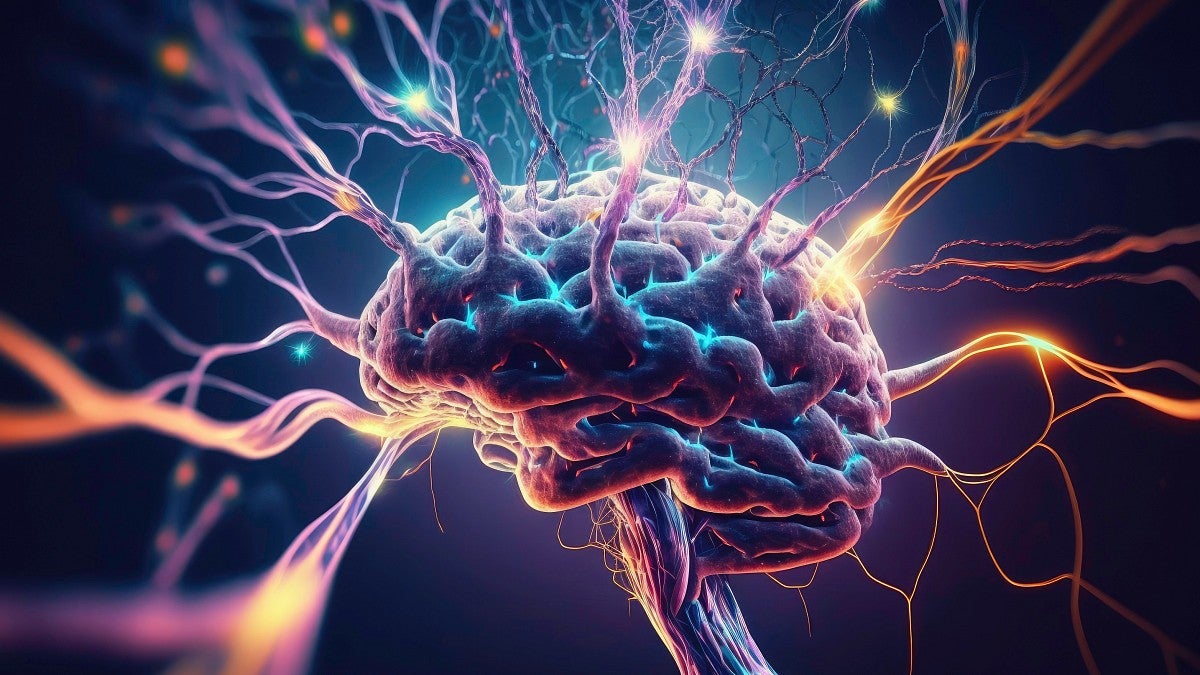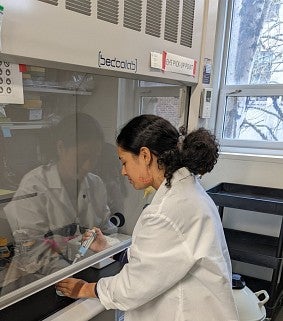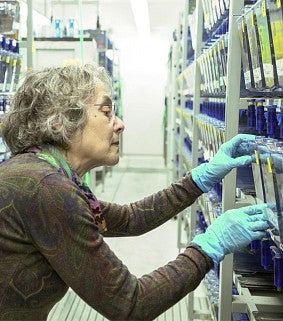
Experiential Learning | Research & Innovation | Community Impact | Career Preparation | Teaching Excellence | 21st Century Liberal Arts | Building Community | Good Vibes | CAS Spotlights | All Stories | Past Issues

February 28, 2024
Blowing Minds
After sustaining a concussion in elementary school, second-year neuroscience major Tanner Rozendal lost the ability to do many of the things he loved.
“I couldn’t go to school for a month. I couldn’t interact with the outside world,” he says. “The concussion specialist said to just wait it out. They couldn’t really explain what was happening to me."

The experience led Rozendal “down a rabbit hole,” he says. He emerged with a desire to study the brain—and specifically to work with well-known neuroscientist David McCormick, a biology professor in the University of Oregon College of Arts and Sciences and director of the Institute of Neuroscience.
“I wanted to understand why all my doctors didn’t really know what was going on and didn’t know how to take care of me,” Rozendal says. “I knew I wanted to do research, and the University of Oregon is one of the only schools on the West Coast that has a neuroscience major.”
Rozendal, who now studies epilepsy in McCormick’s lab, is one of the growing ranks of undergraduate students who were drawn to the UO at least in part because of the College of Arts and Sciences’ burgeoning Neuroscience Program.
While undergraduate neuroscience programs are becoming increasingly common nationwide, the UO’s interdisciplinary program is the first of its kind at an Oregon public university—and it's already becoming a draw for students who are interested in studying the nervous system. Since its launch in 2020, the neuroscience major has grown from 19 students in its first term to 314 declared majors in the fall of 2023.
“You see so much more in the media about the brain and brain research than you did 10 or 20 years ago,” says program director Nicole Dudukovic, senior instructor of psychology, who helped develop the major. “I think it’s in part because of the advent of brain imaging technologies that allow us to look at what parts of the human brain are active when we’re doing different tasks.”
First-year student Sid Lefranc says she chose to attend UO because it’s one of the few schools that offers an established neuroscience program. She’s now working as a research assistant in the Cognitive Dynamics Lab, which studies the ability to think and act flexibly in complex situations.
“A lot of other schools don't have a set degree, so you’d have to create your own major to get the full neuroscience experience,” she says.
Cultivating undergraduate brain researchers
Have you ever held a human brain in your hand? Or watched in fascination as zebrafish neurons make connections in real time? Or helped develop a potential brain implant?

These are just a few of the research highlights that have stood out to UO neuroscience majors over the past four years.
Dana Zaidan, who graduated from the program in 2023, spent all four years in the Eisen Lab studying nervous system development in zebrafish. To determine how much influence microbes have on brain development and behavior, she helped compare the social interactions of zebrafish with normal microbiomes versus those raised in completely sterile environments.
“The most influential part of this experience for me was being able to take a tiny zebrafish brain and use a special microscope that produces an image of its neurons and other cells,” she says. “I would sit down for hours analyzing data and watching these neurons make connections to one another.”
When the lab published its findings last year, Zaidan was one of the study’s co-authors.
“Co-authoring on a paper as an undergrad was a very rewarding experience,” she says. “I was able to see behind the scenes into how much time and work goes into publishing a paper. I had never had exposure to that side of research before.”
Neuroscience research has deep roots at the UO, from the early development of zebrafish as a model organism for lab studies in the 1960s, to the founding of the Institute of Neuroscience in 1979, to the Deku Lab’s recent breakthroughs in materials and microfabrication techniques for neural interfaces, which could be used to address neurological conditions such as epilepsy, Alzheimer’s disease, Parkinson’s disease and depression.
The neuroscience major offers a gateway for undergraduates to get involved in some of this groundbreaking research—although lab openings are not unlimited and can be competitive at the undergraduate level.
“You want somebody who’s interested in what you’re doing, who is excited about doing research and about what the lab is doing,” says Professor Judith Eisen, interim head of the Department of Biology. “You also want someone who is able to think about their results and what those might mean.”
Developing new neural technologies
Second-year neuroscience major Haley Mae Lohf is researching how to use accelerated aging techniques to evaluate the long-term durability of potential neural implant devices in Assistant Professor Felix Deku’s bioengineering lab at the Knight Campus.
“I want to go into medical technology development and research,” says Lohf, who receives a research stipend through the DucksRISE program. “We can take our knowledge of neuroscience and our understanding of material biocompatibilities and create devices that can work with the brain and different live tissues. I want to help patients on the back end by studying and building devices for them.”

In Deku’s lab, undergraduate students are instrumental in creating testing platforms for developing and refining ideas, says the Betsy and Greg Hatton Assistant Professor in Neuroengineering.
“Undergraduates conduct extensive benchtop validation tests, which are vital in assessing the performance of our developed implants,” Deku says. “These testing platforms, once developed and validated by them, become essential tools for the entire lab team in the evaluation of individual devices. Undergraduates in the lab are also intimately involved in designing and fabricating new microelectrode arrays in the Knight Campus Cleanroom, and it is always exciting to see their innovations.”
Lohf met Deku at an annual fall mixer for neuroscience faculty and incoming majors, where undergrads were encouraged to connect with faculty researchers and discover where their interests overlap.
“We’ve had a number of success stories of students who made connections there, and now they’re involved in cutting-edge research because of those connections,” Dudukovic says.
Finding a niche in neuroscience
In the Aging and Vascular Physiology Laboratory, senior neuroscience major Nayantara Arora analyzes a protein known as amyloid beta, commonly found in people with Alzheimer’s disease.
Under the guidance of Ashley Walker, assistant professor of human physiology, she's studying how aging blood vessels relate to the onset and severity of Alzheimer's disease.
“Neuroscience was brand new the year I started at UO. I guess I’ve grown with the major,” says Arora, who in November became the first UO woman to win the prestigious Rhodes Scholarship. She enjoys the major’s flexibility as well as the variety of research opportunities it offers.
“I can take classes on so many different topics, like clinical neuroscience; autism and neurodevelopmental disorders; and cognitive psychology classes,” she says. “There are limitless opportunities for finding a niche within neuroscience.”
The program has proven particularly attractive to undergraduate women, who comprise the majority of neuroscience majors, Dudukovic says.
"Eighty percent of our majors are women, which is awesome to see in a STEM field,” she says.
Lefranc chose to major in neuroscience because she didn’t want to limit herself to just one scientific field. Because the program draws from multiple disciplines, she says, students can tailor the major based on their interests. “It’s not the easiest major, but it’s a labor of love,” she says.
—Nicole Krueger, BA ’99 (journalism), is a communications coordinator for the College of Arts and Sciences.
Chasing Terror in the UO's Upcoming Neuroscience Lab
Neuroscientist Deepu Murty once took a group of research subjects through a haunted house in Philadelphia, where he monitored their heart rates as they encountered various frights.
Back in the lab, they relived their memories of the experience while he scanned their brains to see which circuits were engaged.

“I’m dying to run escape room studies,” says Murty, who will join the University of Oregon Department of Psychology in the fall as an associate professor. His lab, where horror movies often play on TV screens, will study how our motivations affect the way the brain encodes memories.
"There’s this series of findings I’ve been getting pretty excited about,” he says. “There are these mysteries processes happening in your brain that aren’t happening while you’re learning or retrieving memories, but in the nebulous gap between the two. We’re transforming our memories as we go along.”
Murty represents the latest addition to the College of Arts and Sciences’ growing roster of experts who study the relationship between brain and behavior. All three departments that contribute to the university’s neuroscience major—Biology, Human Physiology and Psychology—have made a concerted effort to hire additional faculty with expertise in neuroscience, says Nicole Dudukovic, director of the Neuroscience Program.
“That has been nice to see,” she says. “It shows they recognize that this is an important field and that the neuroscience major is growing.”
It also expands the breadth of courses and research opportunities available to neuroscience majors.
“What is particularly exciting about this major is that while a lot of neuroscience programs might focus on just molecular or just systems or just psychology, this program has open access to all the different things,” Murty says. “That’s a big deal.”
